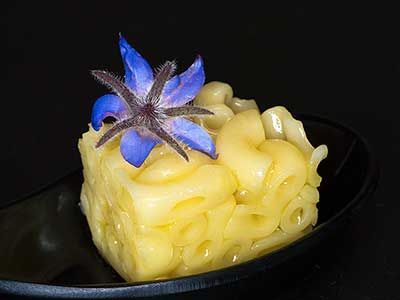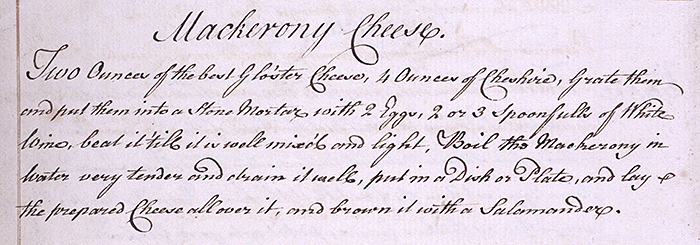August 3, 2015
Amuse-Bouche

macaroni et fromage à l’ancienne
(old-fashioned macaroni and cheese)
It’s going onto fifteen years since I first started looking at old recipes. My first venture only took me back to 1928, but by the end of the first year I was digging around in the 14th century. Now I spend much of my time reading books and manuscripts written in the eighteen century. The period feels very comfortable to view from three hundred years hence.
Although humans have been cooking for millennia, the eighteen century often feels like the start of the modern era. Cookbooks go back to the beginnings of printing and earlier in manuscript form, but the eighteen century feels like the period when they start to flourish. It is a period when many recipes with roots in the middle ages cease to be prepared, and it is the period the gives birth to many modern dishes.
Cooking over an open hearth presented different challenges for the eighteenth century cook than for the modern cook using an induction cooktop and convention oven. At the same time, there are sufficient similarities that I’ve found many eighteen-century recipes easy to prepare in a modern kitchen. In most cases, I’ve been able to prepare the older recipes with only changes in scaling.
Since many of the dishes created in the 18th century are still around today, I’ve found it fun to try to determine which book or manuscript was the first to present a certain recipe. With a ubiquitous recipe like macaroni and cheese, the challenge is to find when the preparation went from pasta sprinkled with cheese to the dish we specifically recognize today as macaroni and cheese.

I started thinking about macaroni and cheese when an old recipe was posted on a blog I follow. The recipe was for Maccarony Cheese and was written between 1765 and 1830. This recipe combined the macaroni with a cheese and sherry-based custard. Similar, but still different, from our modern macaroni and cheese where the cooked macaroni is combined with a cheese sauce.
Elizabeth Raffaid’s recipe, To dress Macaroni with Permasent Cheese, from 1769 comes closer to serving the macaroni in what a modern diner would recognize as cheese sauce.
Boil four Ounces of Macaroni ‘till it be quite tender, and lay it on a Sieve to drain, then put it in a Tossing Pan, with about a Gill of good Cream, a Lump of Butter rolled in Flour, boil it five Minutes, pour it on a Plate, lay all over it Permasent Cheese toasted; send it to the Table on a Water Plate, for it soon goes cold.
In the second part of the first volume of Le cuisinier moderne, qui aprend donner toutes sortes de repas, Vincent LaChapelle describes a Pâte de Macaronis, en maigre where cream and parmesan are mixed with the cooked, hot macaroni and then finished with a little butter and cinnamon. The year was 1735. In the 1736 travelogue, Travels Through the Low Countries: Germany, Italy and France, John Ray describes Italians scraping cheese over oiled macaroni and vermicelli. In a similar vein, the Journal Œconomique, ou Mémoires, Notes et avis sur l’Agriculture, Les Arts, le Commerce, &c. of 1761 describes Italians grating cheese over macaroni. More examples are necessary, but this could be the transition period between simply grating cheese over macaroni and combining the macaroni with a cheese sauce. The addition of breadcrumbs on the surface and a bit of baking came later.
Even though I was considering making an old-fashioned macaroni and cheese, I still wanted it to fit my guidelines for an amuse-bouche, specifically, no more than two bites and of intense flavor. From my formative years of eating leftover macaroni and cheese produced by following the directions on the blue and yellow box, I knew that when cold, the combination could be formed into a crude shape. Unfortunately, I also knew that upon reheating leftover macaroni and cheese, it would become a loose mass, unable to hold whatever shape it was formed into. This caused my trials to be separated into two parts: initial preparation and reheating.
The goal of producing the initial rectangular block started with choosing a form. I conjectured that my 8- by 12-cm (3-3⁄16- by 4-3⁄4-in) Japanese cake pan with a removable bottom would produce twelve cubes of an appropriate size. The cubes would be about 3 cm (1-3⁄16 in) long by about 2-2⁄3 cm (1 in) wide. I guessed that if I filled the form with uncooked macaroni to a height of about 2 cm (3⁄4 in), the cooked macaroni and cheese should press to close to 3 cm (1-3⁄16 in) in height. The weight of the uncooked macaroni came to 60 g (2-1⁄8 oz). The form was brushed with oil and the bottom and sides lined with plastic wrap. The bottom of the removal bottom was also oiled.
The macaroni was cooked in salted, boiling water. While the macaroni was cooking, 45 g (1-5⁄8 oz) of double Gloucester cheese was grated and 30 ml (2 T) of heavy cream were measured out. When the macaroni was finished cooking, it was well drained and combined with the cream over moderate heat. When the cream was hot, the grated cheese was added. With rapid stirring, the cheese melted and the mixture became smooth. The concoction was transferred to the form. The top was leveled by firmly pushing the removable bottom onto the surface of the macaroni mixture. A small loaf pan was mostly filled with water and placed on top of the assembly. The weighted assembly was refrigerated overnight.
The next morning, the assembly was removed from the refrigerator. The weight was removed. The removable bottom was removed. This exposed the plank of macaroni and cheese, which was carefully removed from the cake pan. Using a long slicing knife and single strokes, the plank of macaroni and cheese was cut into twelve near cubes.
At this point, I really had no idea how I would reheat the cubes. I like cold macaroni and cheese, but I think I’m in the minority on that subject. With low expectations, I separately tried frying, broiling, and torching the cubes. My low expectations were met. The cubes disintegrated or burned. Finally I tried a method I generally avoid: microwaves. The microwave oven’s ability to heat an object from the inside to the outside worked great in this case.
For each serving, a single cube was placed on a microwave-safe spoon. The serving was reheated using the microwave oven set for 10 s at about 500 w. Each spoonful was separately reheated. For decoration and contrast, a single borage flower was added to each serving.
© 2015 Peter Hertzmann. All rights reserved.
